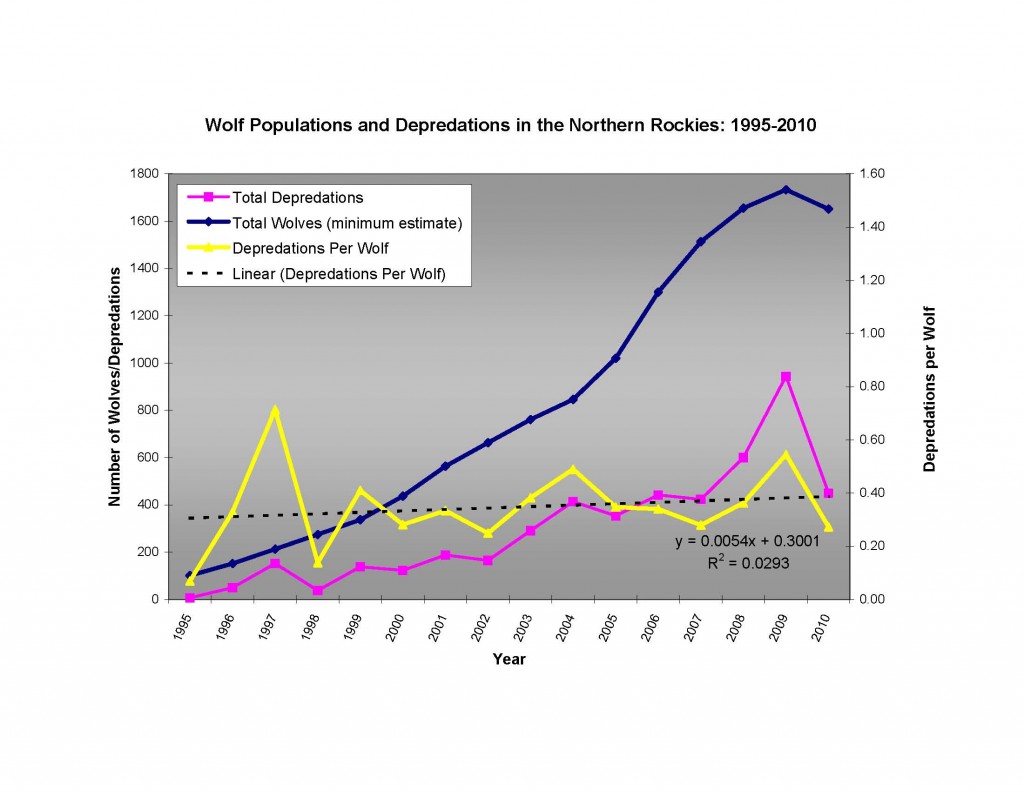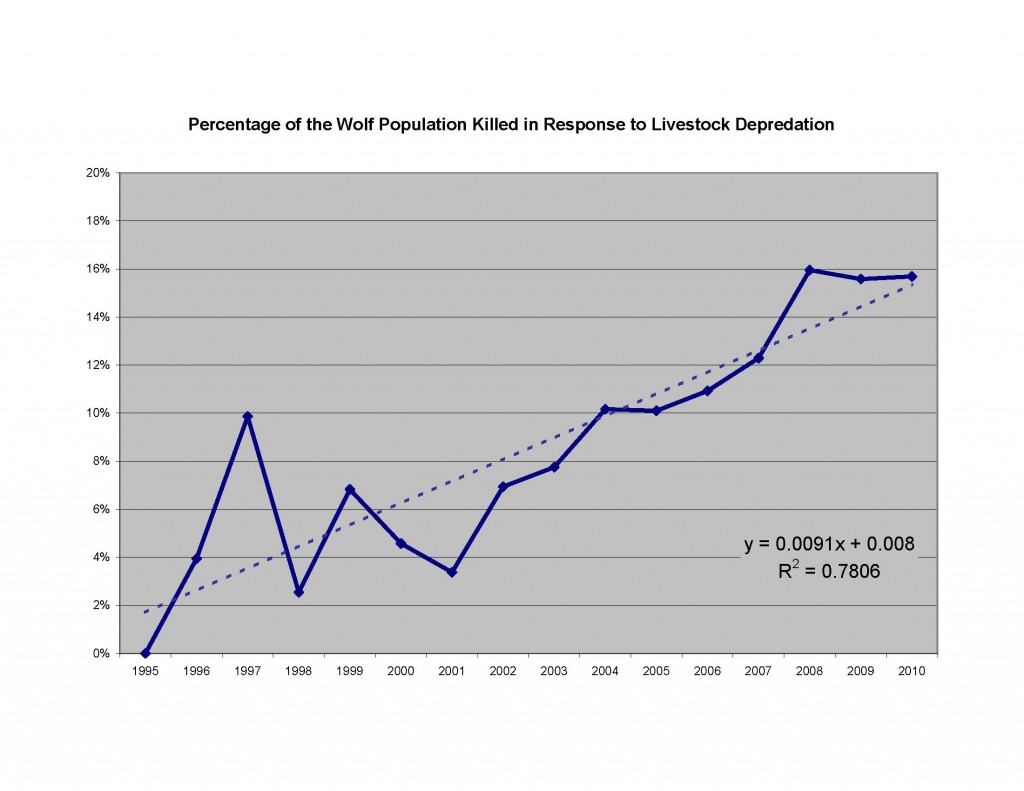Several recent discussions on The Wildlife News have
focused on trends in wolf depredations (i.e. killing of domestic
animals), and pondered what they mean for the future of wolves’
management. The notion that per capita depredations (i.e. depredations
per wolf) should increase with time is implicit in the U.S. Fish and
Wildlife Service’s (FWS) 2009 Final Rule, which, in part, justifies the
removal of wolves from federal ESA protections noting that “nearly all
suitable habitat in Montana, Idaho and Wyoming is currently occupied and
areas predicted to be unsuitable remain largely unoccupied” (74 Fed Reg
at 15,158). According to FWS, unsuitable habitat is
characterized by “high densities of livestock compared to wild
ungulates, chronic conflict with livestock and pets, local cultural
intolerance of large predators” (74 Fed Reg at 15,127). If most or all
of the suitable habitat is now occupied in the northern Rockies, and
habitat is made unsuitable by conflict with pets and livestock and
cultural intolerance, then we should expect:
(1) Rates of conflicts with domestic pets and livestock should increase with time as wolves push outward from “core” habitat and occupy less suitable habitat (i.e. places where conflicts should be more common).
(2) Rates of human-caused mortality should increase as more wolves come into conflict with people and are subsequently killed in response.
With these expectations in mind, I download the most recent data from the FWS and set about running some very basic analyses. Specifically, I plotted a regression line through 16 years of data on confirmed per capita wolf depredations, as well as the percentage of the wolf population killed/controlled annually. In layman’s terms, I sought to determine if per capita conflicts (depredations) and per capita removals (controls) were increasing with time (specifically the 16 years since reintroduction).

As expected, figure 1 shows an increase in total confirmed depredations (pink line) that largely mirrors the growth in the wolf population (blue line). However, per capita depredations, though highly variable, have remained essentially stable. Specifically, the regression line indicates depredations increased by 0.005 per wolf, per year. There were an average of .33 depredations per wolf in the first five years (1995-1999), and 0.36 depredations per wolf over the last five years (2006-2010). In layman’s terms, depredations per wolf have not increased substantially with time as one would expect if wolves were occupying less suitable habitat.
I used a similar approach to determine if wolves were being killed more frequently in response to conflicts. First, I calculated the percentage of total wolves that were legally killed in response to depredation events (i.e. controls / total wolves) each year (1995 – 2010), then I plotted a regression line through these data points. This time (figure 2) you can see a clear increase in per capita control, which averages 4.6% over the first five years (1995-1999) and 14.1% over the last five years (2006-2010).
The lack of increase in per capita depredations corresponding with a significant increase in per capita control indicates that more wolves were being “controlled” per depredation in recent years. How many? On average, 0.12 wolves were killed for every depredation in years 1995-1999, while an average of 0.41 wolves were killed per depredation in 2006-2010 (2010 was the highest year, 0.58).
What does all of this mean? I suspect that depends upon who answers the question. For me, the lack of increase in depredations per wolf over the recovery period suggests the habitat occupied by wolves throughout the entire recovery period (1995-2010) was “suitable”, and there may be more suitable habitat than the FWS originally thought. However, the increase in per capita control suggests that the FWS was being aggressive in their attempts to “maintain the peace” (i.e., keep conflicts to a minimum). If wolves were more aggressively controlled in “unsuitable” habitat as time passed, this could explain why depredations per wolf failed to increase; that is, one might interpret these data as suggesting that the FWS’s increasingly aggressive control helped prevent an increase in per capita depredations. Yet, it is impossible to know what would have happened were another course of action pursued.
These data might also be interpreted as helping FWS fulfill a ‘prophecy of unsuitability’. What do I mean? If wolves were controlled more aggressively in areas deemed “unsuitable” in order to prevent conflicts, then the FWS’s actions could have actually contributed to the “unsuitability” of this habitat by being the source of “high rates of wolf mortality” that are cited as the defining characteristic of unsuitable habitat in their models. Would wolves have thrived without aggressive control? Would per capita depredations have increased along with their presence in livestock country? Probably; but again, we can only guess…
source
(1) Rates of conflicts with domestic pets and livestock should increase with time as wolves push outward from “core” habitat and occupy less suitable habitat (i.e. places where conflicts should be more common).
(2) Rates of human-caused mortality should increase as more wolves come into conflict with people and are subsequently killed in response.
With these expectations in mind, I download the most recent data from the FWS and set about running some very basic analyses. Specifically, I plotted a regression line through 16 years of data on confirmed per capita wolf depredations, as well as the percentage of the wolf population killed/controlled annually. In layman’s terms, I sought to determine if per capita conflicts (depredations) and per capita removals (controls) were increasing with time (specifically the 16 years since reintroduction).

As expected, figure 1 shows an increase in total confirmed depredations (pink line) that largely mirrors the growth in the wolf population (blue line). However, per capita depredations, though highly variable, have remained essentially stable. Specifically, the regression line indicates depredations increased by 0.005 per wolf, per year. There were an average of .33 depredations per wolf in the first five years (1995-1999), and 0.36 depredations per wolf over the last five years (2006-2010). In layman’s terms, depredations per wolf have not increased substantially with time as one would expect if wolves were occupying less suitable habitat.
I used a similar approach to determine if wolves were being killed more frequently in response to conflicts. First, I calculated the percentage of total wolves that were legally killed in response to depredation events (i.e. controls / total wolves) each year (1995 – 2010), then I plotted a regression line through these data points. This time (figure 2) you can see a clear increase in per capita control, which averages 4.6% over the first five years (1995-1999) and 14.1% over the last five years (2006-2010).

The lack of increase in per capita depredations corresponding with a significant increase in per capita control indicates that more wolves were being “controlled” per depredation in recent years. How many? On average, 0.12 wolves were killed for every depredation in years 1995-1999, while an average of 0.41 wolves were killed per depredation in 2006-2010 (2010 was the highest year, 0.58).
What does all of this mean? I suspect that depends upon who answers the question. For me, the lack of increase in depredations per wolf over the recovery period suggests the habitat occupied by wolves throughout the entire recovery period (1995-2010) was “suitable”, and there may be more suitable habitat than the FWS originally thought. However, the increase in per capita control suggests that the FWS was being aggressive in their attempts to “maintain the peace” (i.e., keep conflicts to a minimum). If wolves were more aggressively controlled in “unsuitable” habitat as time passed, this could explain why depredations per wolf failed to increase; that is, one might interpret these data as suggesting that the FWS’s increasingly aggressive control helped prevent an increase in per capita depredations. Yet, it is impossible to know what would have happened were another course of action pursued.
These data might also be interpreted as helping FWS fulfill a ‘prophecy of unsuitability’. What do I mean? If wolves were controlled more aggressively in areas deemed “unsuitable” in order to prevent conflicts, then the FWS’s actions could have actually contributed to the “unsuitability” of this habitat by being the source of “high rates of wolf mortality” that are cited as the defining characteristic of unsuitable habitat in their models. Would wolves have thrived without aggressive control? Would per capita depredations have increased along with their presence in livestock country? Probably; but again, we can only guess…
source

No comments:
Post a Comment